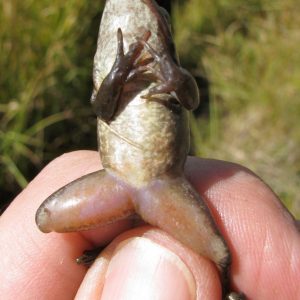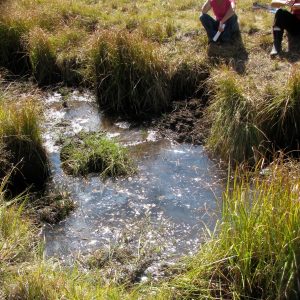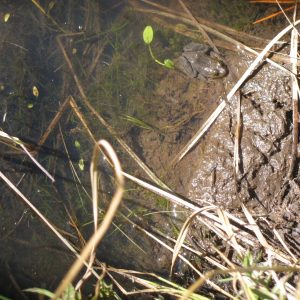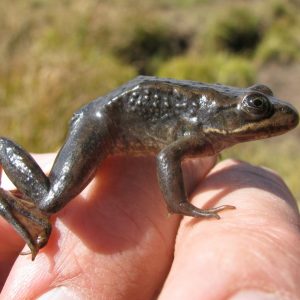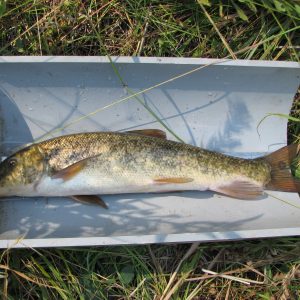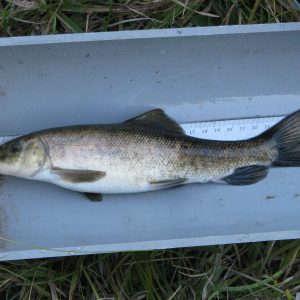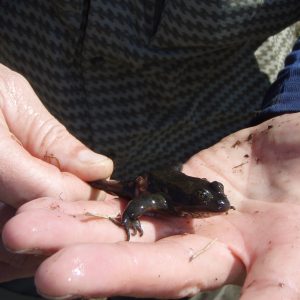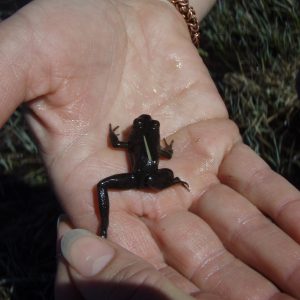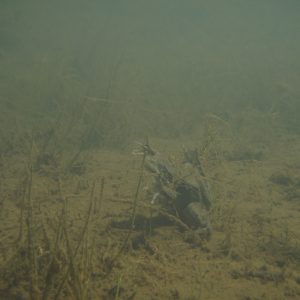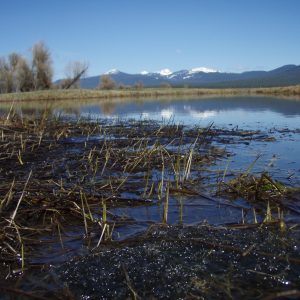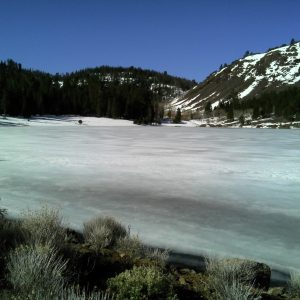I never thought I’d find a seasonal survey job working with 8+ very different species, but my CLM internship with the Klamath Falls Fish and Wildlife Office (KFFWO) provided that. I have learned about not only a wide range of new species in this unique ecosystem, but also about my favorite part: the bigger picture – the chronic environmental problems that have led to the decline of some of these species and why. I also picked up some useful skills every wildlife biologist needs including new survey methods, renewed GIS skills, off road driving and electrofishing.
I’ve worked in teams before – one that comes to mind was working on a year-long research project at university, where we met weekly and then conducted fieldwork together. We had our challenges in terms of workload equality and team member reliability, but we pulled through in the end and we got on really well. This internship was a whole new level of teamwork. Not only did we spend whole weeks camping together in the field and sharing desk spaces in the office, but three out of four of us decided to live together. Here’s the thing about us: we’re all girls, we’re all intelligent and passionate about our work, we’re all stubborn and we all have radically different personalities. We’ve had a bit of an emotional rollercoaster this summer through our work and personal lives, and we’ve had our disagreements, but we’ve come out of it still speaking to each other. To deal with our disagreements and personality clashes, we’ve all had to rethink our words and actions and come up with ways to accommodate each other. What was most important to us was to maintain our professional work ethic and relationships and also to preserve our personal relationships and appreciation of each other. It’s been challenging, but I think we’ve all learned something from it, if only to be cautious when deciding to work on an all-female team… (haha). I have a new understanding of intimate teamwork.
Oh, and then there were the more practical things we learned, like how the Endangered Species Act works to protect endangered species in all its strengths and faults. The species I was lead for (Oregon Spotted Frog, Rana pretiosa) was proposed for Threatened status under the ESA just last month, and I had the exciting opportunity to present our frog fieldwork at a public workshop. The presentations went well. Private landowner attendance was limited but they were there, as well as Klamath County Commissioner Tom Mallams. I feel fortunate to be able to work with this species that was stuck at Candidate status for the last 20 years and see it moved forward to a proposed listing.
This CLM internship has been a unique experience I would never have had without the Chicago Botanic Garden. I also very much enjoyed the professional development opportunities in the form of attending the International Congress on Conservation Biology in Baltimore this year, where I made some connections that have been important for consideration of my next career steps. Thanks CLM and KFFWO!
Author Archives: Caitlin Chew
How do we save the frogs?
As project lead on the Oregon Spotted Frog surveys, I was invited to come on a site visit in June 2013 to a historically important creek along with private landowners, US Forest Service staff and private consultants. The creek was Jack Creek, and frog populations here crashed from over 300 egg clusters each year to less than 30 within a few years. It is thought that the primary driver was an intense drought year combined with overgrazing. Since then, a number of measures have been implemented to try and remedy this severe population crash. Radio-tagged beavers were brought into the creek in the hopes that they would re-establish and build up ponds along the creek where old dams are deteriorating or are lost. Grazing intensity is being more carefully managed by USFS. The purpose of our visit was to review the habitat and determine what else could be done to restore the creek. A developing headcut along the creek is becoming more pronounced and moving up the creek bed, threatening to drain surrounding ephemeral wetlands and increase sediment transport via faster, straighter flows. The private consultants that were present on our field visit had a proposal to halt this development by filling the headcut in with sediments and allowing the stream to re-establish itself as a meandering creek. Their company had recently performed similar work at a Nature Conservancy property in the area, and initial results were promising. I asked them when it had been implemented and they said October of the year before.
The solution brought about some questions; what’s to stop the next seasonally high flow from washing the sediments out and undoing the restoration effort? Their previous work had not been implemented very long ago; what was the life expectancy of these projects? However, these concerns were not expressed by other members of the group. Perhaps it is because the system is primarily spring-fed and does not follow traditional flood trends. Perhaps it is because there is urgency to implement restoration now, before the frog gets listed as Threatened and even restoration projects on federal lands require a formal Biological Assessment. They spoke of spending a few days out there prior to restoration construction to catch whatever frogs they could and temporarily relocate them out of harms’ way.
So I spoke with the private landowner on our way back to our vehicles from the creek. The man owned land adjacent to the forest service land and he grazed his cattle along the creek on the USFS land. His opinion was that the land had been grazed for over a hundred years (by his ancestors) and that the frogs had been coexisting quite happily with the cattle in that time frame. Indeed in the absence of natural wildfires and presence of introduced plants, well-managed grazing can provide the disturbance the landscape needs to provide suitable habitat for Oregon Spotted Frogs (and other species). He thought we hadn’t really given the beavers the chance to do their part, and that the best approach would be to give the system time to work itself out. USFS and other public stakeholders are afraid that the frogs are running out of time, and more radical actions need to be taken. I’m not sure what the best approach is, I agree with both parties but I wonder about the impact of the proposed restoration effort.
We revisited the area on September 20th. We were looking for frogs in a newly colonized area where they had been seen 4 weeks previously by a member of the public who previously worked for the Forest Service. We found 3-4 subadults on a portion of USFS property adjacent to that same private landowners’ land, holding on in a very small pool that had been heavily impacted by cattle. Cows had been found in this particular land parcel previously and the landowner built a new fence to remedy the situation. So what now can be done? The biggest concern was water permanence; these particular pools exist along the largely dry creek bed, and seemed to be spring-fed by a seep adjacent to the channel. This seep had been heavily trampled. The biologists debated whether an artificial addition of water would be helpful or a waste of resources.
This whole experience brings up some very important questions in my mind. In a system that has been heavily altered, how much manipulation should be done to save an endangered species? When is it better to do something over nothing? The short-term plan is to contact the landowner about the cattle again and warn of potential loss of grazing rights. Plans are moving forward for the head cut restoration. The evidence of range expansion in the frogs at this site are a good sign, I just hope they are expanding into the right place.
Fishing
We packed all our gear into USFWS’s largest truck – a Dodge Ram. We had two electrofishing backpacks, waders, nets, 16 gallons of water, and four girls’ worth of camping gear and food. Needless to say packing the truck was a bit of an art. So off we went, the project biologist leading the way in a sedan and the Ram following close behind. The trip was about 2.5 hours, only one hour of which was on paved roads. From there it was an hour and a half driving on dirt roads to a campsite and nearby survey areas. We were conducting presence/absence surveys for endangered suckers (Lost River, Klamath Large Scale, Shortnose) in along streams in the Clear Lake portion of the Modoc National Forest in California. Our supervisor showed us the survey sections on the map with a general idea of site priority, showed us where we should deploy our two sondes (named Curly and Moe), then turned around and drove back to Klamath Falls, Oregon. And so we camped the night amongst coyotes howling and owls hooting overhead and started surveying the next day.
The first section we managed to electroshock successfully and most of the fish were Dace and the beautiful and brightly colored Green Sunfish. We pretty quickly realized pretty much all of our patched and re-patched waders had holes in them. But we caught a few juvenile suckers. For each pool that contained suckers, we mapped and took depth measurements – which, in the absence of a meter stick, involved myself wading across the sometimes deep pools and yelling out where the water came up to (2” above knee! Crotch deep! Brr I’m wet now). Then we reached much larger, deeper pools which were much more difficult to shock effectively. The fish would feel the shock and swim away before we could stun and/or catch them. Many pools were too deep for our (leaky) waders and we gave up part-way. Then we reached a wide, waist deep pool and by shocking along the edges the girls caught a large fish which was – Eureka! A sucker! We hadn’t expected to catch such big guys out here and it was super exciting.
The next few days of surveys yielded many Scaulpin, bullfrogs, and more difficult survey conditions. Our last survey site contained large, deep pools with descent size fish that we suspected were suckers, so we employed as many tactics as we could think of to catch them – we tried herding them to one side of the pond and then shocking, we tried leaving the probe in the water and waiting till they were close and then shocking – but this tactic was not particularly successful; they swam as soon as you pushed the trigger. In the end we managed to catch a few through a combination of herding, sneak attacking, free netting and pure luck. We did catch some more big suckers and the biologists at USFWS were pretty thrilled – their presence was unknown as far up the streams as we caught them. We were not so excited about backpack electroshocking in leaky waders.
Everyone likes a treasure hunt
We started the week with an orientation and safety meeting. The members of our team included a few Fish and Wildlife employees, a couple private consultants, an ever-cheery volunteer, and ourselves (four CLM interns). We were here to survey an endangered endemic plant. The largest population of this particular plant, however, happens to be adjacent to where planes take-off and land; which means we were surveying at the Klamath airport! The safety training was a solid morning and covered the meanings of taxiway and runway markings, safety zones and the theory behind them, and was happily interspersed with some good humor. Turns out this particular airport had more than one lost car inadvertently take a wrong turn and end up driving down the runway. Thus adequately briefed, and with hearing protection in hand, we commenced our week of airport surveys for the protected Austragalus applegatei.
Because of impending developments (specifically, a new runway), our surveys aimed to find and accurately map all individuals in previously-identified occupied areas. Our basic method was to walk arms-length apart up and down fields until we encountered plants, then flag each individual in the area (A. applegatei is found in clusters), and continue searching while a GPS team mapped polygons around the cluster. Simple, right? There were a few extenuating circumstances; perpetual wind, rain and even hail, airport escorts, limited time in safety areas, lack of any cover for female surveyors (goodbye modesty, hello air traffic control!), airforce jets taking off and landing right next to us, and coordinating a large group of people from multiple agencies.
One of the best aspects of biological surveys is that same joy as a kid on Easter morning when you wake up to a treasure hunt for coloured eggs, or the thrill in playing pirate and hunting for hidden gold. I used to build my own treasure hunts and try to make my sister follow them (well, maybe I’m a little unusual, because she got bored pretty fast). Walking through the field, flags in hand, there was always a little “hooray!” when one of us found a plant and dutifully planted a flag. We counted over 11,000 plants in those 5 days, and by day 2 the image of A. applegatei was burned in each of our minds. I was afraid to blink too long for fear of missing seeing the little plant. But even after such long days, I still had a little satisfaction with each plant counted. It feels somewhat more significant finding endangered species, versus eggs and chocolate. We also found a pygmy horned lizard, and saw many of the beautiful Melissa’s butterfly that feeds on A. applegatei.

Cheers,
Caitlin Chew
USFWS Klamath Falls
Fair Weather Frogs make for excellent surveys
You might think amphibian surveys would take you to cool, damp, dark places. With the Oregon Spotted Frog, not so! During our first few weeks as I sat in the office, having taken on the OSF as Species Lead, I read the following as ideal survey conditions: warm, sunny days with little or no wind. Well that sounds pretty ideal indeed! While we waited for our supervisor to return from a training, we were set on some office work and whatever field trips staff undertook. When our supervisor returned, the first thing we hear is that it’s a hot, hot year and the frogs are spawning whole weeks before they’d ever spawned before (yikes!). Thus launched one crazy month of survey after survey.
Like many rare species, the OSF is quite shy and hard to find. Over the years, as surveys yielded fewer and fewer numbers of adults (my last few days of data reorganization have started to make this quite clear to me), the Klamath Falls FWS office changed survey tactics to focus more on egg mass surveys, which are far less mobile and cryptic then their originators. We had one special day this season where we saw a few adults and one subadult Oregon Spotted Frog (it was one of the warmest, sunniest days). OSF spawn when water reaches warmer temperatures in the shallows, usually around May through June/July, and the egg masses develop over 2-3 weeks. The trick is to catch the window when you can find the highest density of egg masses and get to the sites to survey, but each site window varies depending on local water temperature conditions, altitude, location, etc. As it was we caught the tail end of spawning at most sights, seeing little OSF tadpoles hatch out and occasionally get eaten by leeches. The presence of hundreds of chorus frog eggs is also a sign that we are too late.
We have been balancing local surveys around Upper Klamath Lake of known territory, with surveys of historic territory in the Modoc National Forest down in California. This was quite exciting as we have had the chance to look for OSFs where they have not been seen in the last 100 years or so, and had we caught any evidence of their existence it would have made some ripples. These surveys turned up negative in the end, but my fellow intern and I got to spend several nights camping in the Warner Mountain Wilderness, the past 3 weeks hiking into remote lakes and creeks and generally absorbing the beauty that surrounded us, including the occasional coyote spotting. Last week however we got caught in a few storms, and neither the frogs nor us were experiencing prime operating conditions!
Well, that just about wraps up OSF surveys for the year, next week will be working with several valued, yet endangered, fish species in the Klamath Basin. I can’t wait to see what comes next!
- California surveys of presumed historic habitat take us to icy lakes
What species are we working with today?
The Klamath Basin is a unique area of fascinating volcanic landscape features, endemic plants and animals, and a bird’s paradise (or birder’s, in the case of my co-workers). It has been such a breath of fresh air getting out of the city and into this high desert, where bald eagles can be seen casually flying overhead and river otters play in the irrigation canals. While the flora, fauna and human inhabitants of this sleepy town stir from their winter dormancy, we are spending our days looking to see which nests the bald eagles are returning to raise their young in, surveying frog habitat for the presence of the Oregon Spotted Frog, and collecting mycorrhizal funghi of the highly endemic Applegate’s milkvetch to raise seedlings.
I am extremely excited to have this opportunity to work with so many biologists of different backgrounds and specialties, and to work with such a wide variety of threatened and endangered species. Many days we come to the office uncertain what the day will bring; whether we will be surveying eagles’ nests (weather permitting), collecting soil, recording lake depth, netting fish, or in the office photo-documenting fish samples. Currently my favourite days are eagle surveys. Thanks to nest fidelity (those nests are pretty large and personally I would not be too keen to build a new one each year either), the department keeps their eye on known nests from season to season. In early spring, we drive to a vantage point some distance from the base of the tree and look for the presence of adult eagles either in the nest or flying nearby. If we don’t see any activity, we wait a little while but the nest will be checked again later in the season. In several months’ time, the nests will be checked again for chicks.
Next week promises to bring more frog surveys and I can’t wait to get out in the region’s various rivers and wetlands and find frogs’ eggs.

